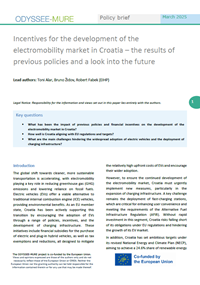Summary
Key questions
- What has been the impact of previous policies and financial incentives on the development of the electromobility market in Croatia?
- How well is Croatia aligning with EU regulations and targets?
- What are the main challenges hindering the widespread adoption of electric vehicles and the deployment of charging infrastructure?
Lead authors: Toni Alar, Bruno Židov, Robert Fabek (EIHP)
Introduction
The global shift towards cleaner, more sustainable transportation is accelerating, with electromobility playing a key role in reducing greenhouse gas (GHG) emissions and lowering reliance on fossil fuels. Electric vehicles (EVs) offer a viable alternative to traditional internal combustion engine (ICE) vehicles, providing environmental benefits. As an EU member state, Croatia has been actively supporting this transition by encouraging the adoption of EVs through a range of policies, incentives, and the development of charging infrastructure. These initiatives include financial subsidies for the purchase of electric and plug-in hybrid vehicles, as well as tax exemptions and reductions, all designed to mitigate the relatively high upfront costs of EVs and encourage their wider adoption.
However, to ensure the continued development of the electromobility market, Croatia must urgently implement new measures, particularly in the expansion of charging infrastructure. A key challenge remains the deployment of fast-charging stations, which are critical for enhancing user convenience and meeting the requirements of the Alternative Fuel Infrastructure Regulation (AFIR). Without rapid investment in this segment, Croatia risks falling short of its obligations under EU regulations and hindering the growth of its EV market.
In addition, Croatia has set ambitious targets under its revised National Energy and Climate Plan (NECP), aiming to achieve a 24.6% share of renewable energy in transport by 2030. This represents a significant leap from the less than 1% achieved in 2023, necessitating a comprehensive strategy that integrates renewable energy sources with electromobility development.
While the Croatian electromobility market is still in its early stages, collaboration between the government, private sector, and local communities is essential to building a sustainable and efficient transportation ecosystem.
Current situation concerning electromobility in Croatia
One of the largest consumers in Croatia is the transport sector with a 37 per cent share in total final energy consumption. Consumption in the transport sector reached a staggering 112.5 PJ in 2023, with the road transport dominating the energy consumption within the sector, representing almost 90 per cent of the total.
Figure 1: Modal structure of passenger kilometres in 2023
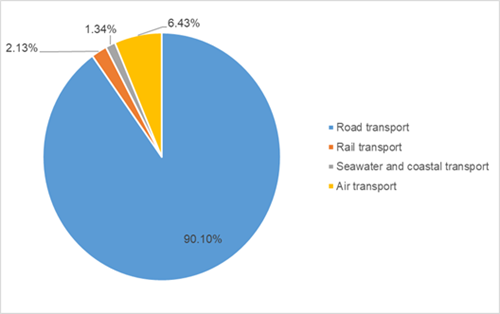
Source: EIHP
Structurally, passenger vehicles account for over 65 per cent of energy consumption within road transport, while light and heavy-duty vehicles represent approximately 30 per cent, other modes of transport represent the remaining 5 per cent. In Croatia, the structure of passenger-kilometres reveals that road transport remains the primary mode for freight and passenger movement.
Figure 2: Number of newly registered electric vehicles in Croatia in the period from 2007 and 2024
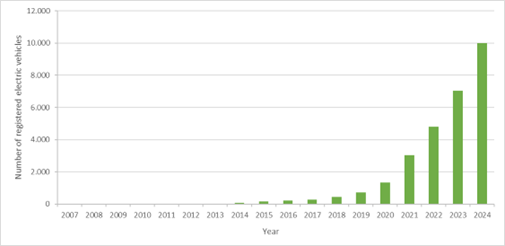
Source: CVH
Figure 2 shows an exponential trend in the number of registered EVs with a strong start from 2020. Between 2007 and 2019, the growth was not substantial as the years after, with very few vehicles being registered annually. The slow rate indicates that technology, affordability and infrastructure as well as a lack of incentives and regulations have been the root cause for such a trend.
Concerning the infrastructure necessary to sustain electromobility, by the second quarter of 2024, the total number of EV charging points has reached more than 1,500, reflecting an average annual growth rate of roughly 40 per cent since 2020. In terms of charging technology, about two-thirds of the stations enables AC charging, while the remaining one-third provide DC charging. Within the AC category, an overwhelming 95% are classified as medium-speed AC chargers with three-phase power, delivering between 7.4 kW and 22 kW.
Concerning TEN-T network coverage, EV charging facilities are available at 64 locations close to motorways. These sites collectively offer 178 dedicated charging points. A total of 108 chargers have been installed to support these points, with the majority offering DC fast charging.
Figure 3: Recharging points – AFIR classification in the period from 2020 to 2024
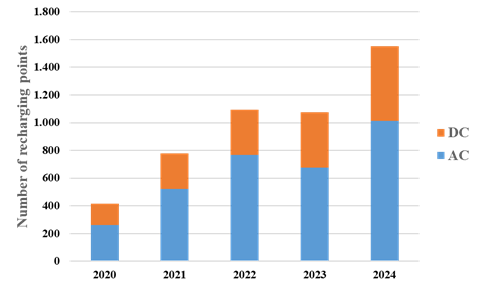
Source: EIHP, EAFO
Measures aiming to improve electromobility in Croatia
Croatia's national strategic and legal framework is well-aligned with the European regulatory environment, ensuring consistency in policy implementation and market development. The revised National Energy and Climate Plan (NECP) plays a crucial role in setting ambitious targets for electromobility, particularly by supporting the co-financing of energy-efficient vehicle acquisitions and the expansion of charging infrastructure.
Achieving the RES share goal will require not only the integration of renewable energy sources but also substantial investments in EV adoption and charging infrastructure.
The Environmental Protection and Energy Efficiency Fund plays an active role in encouraging the transition to sustainable transportation by co-financing the purchase of energy-efficient vehicles. Between 2014 and 2020, the Fund co-financed the acquisition of over 4,500 electric, hybrid, and plug-in hybrid vehicles, representing an investment of more than €20 million. Since the launch of the "Drive Economically" project in 2014, approximately 3,200 electric passenger vehicles have been co-financed. Given that over 65% of all EV users have utilized the incentive measure for EV purchases, this initiative has been effective in accelerating the market's growth.
Between 2021 and 2022, approximately €22.2 million was allocated through public calls to support energy-efficient vehicle purchases, benefiting more than 2,500 recipients—primarily for M1 category passenger cars. For 2024, the Fund has set aside €15 million for the same purpose, indicating the continuation of strong financial support for EV adoption.
Notably, data suggest that on average around 35% of newly registered electric vehicles in recent years have been purchased without direct government subsidies. This trend suggests that the market is gradually becoming more self-sustaining, as consumer interest in EVs grows independently of financial incentives. Such developments indicate a broader shift in market dynamics, with EV adoption increasingly driven by factors beyond direct government support.
Figure 4: Number of registered M1 category electric vehicles in Croatia from 2018 to 2022
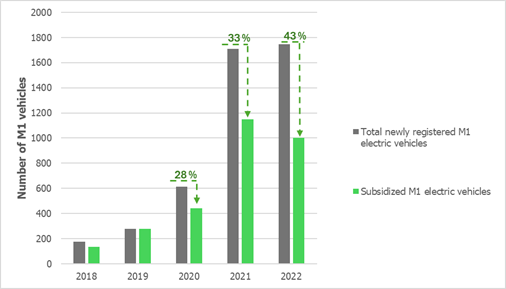
Source: EIHP
The development of a comprehensive EV charging network is a critical component of Croatia’s electromobility strategy. The Environmental Protection and Energy Efficiency Fund has also supported infrastructure expansion by co-financing charging station construction. In 2019, the Fund launched a Public Call allocating €769,792 to support the installation of charging stations with a minimum power output of 50 kW (DC) or 22 kW (AC). Eligible costs included equipment, installation, commissioning, and software for payment and analytics. This funding was distributed among various counties and cities. However, the initiative did not cover the development of EV charging stations along motorways, creating a significant gap in high-power charging infrastructure.
To align with the European Union’s transport network requirements, Croatia must intensify efforts to expand its alternative fuel infrastructure, particularly along the trans-European transport corridors. Currently, there is a substantial discrepancy between existing infrastructure and the AFIR-mandated targets for 2030. A key challenge remains the deployment of high-power charging points (output power of 150 kW and above), which are essential for supporting long-distance EV travel and ensuring full integration with the broader European transport network.
Enabling factors and challenges
Croatia has emphasized the importance of electromobility in its strategic planning for the transport and energy sectors. To facilitate this transition, a dedicated law governing the deployment of alternative fuels infrastructure has been enacted, alongside the development of the National Policy Framework (NPF). These measures create a structured regulatory environment that supports the expansion of electric vehicle (EV) infrastructure.
One of the key enablers for fast charging infrastructure deployment is Croatia’s streamlined construction regulations. Under these regulations, electric charging stations are classified as simple structures, meaning a construction permit is not required. This significantly simplifies the construction and grid connection process, reducing administrative barriers for investors and accelerating project timelines.
Furthermore, the role of electromobility in strengthening the electric power system is recognized in the Law on the Electricity Market. This legal framework acknowledges the potential of EV integration in enhancing grid stability and energy management, further supporting the deployment of charging infrastructure.
Despite these regulatory advancements, several challenges hinder the rapid expansion of fast charging infrastructure in Croatia:
- High Grid Costs The current grid connection methodology and tariff structure for electricity use—regulated by the Croatian Energy Regulatory Agency (HERA)—impose high costs on EV charging infrastructure investors. These costs significantly impact the financial viability of fast-charging station projects, particularly in the early stages of market development when operators cannot fully transfer expenses to end users. In addition to high capital expenditures for charger construction, investors face substantial operational costs due to network charges. Since the market for EV charging is still developing, there is limited flexibility to recover these costs from end-users.
- Grid Connection Process and Power Leases Securing power leases for fast chargers and integrating them into the electrical grid is a complex and time-consuming process. One of the major regulatory requirements for high-power charger deployment is obtaining an Elaborate for Optimal Technical Connection Solutions, which involves an extensive network analysis conducted by DSO (the national distribution system operator). The preparation of these Elaborates for multiple charging station locations can cause significant delays in deployment and, in some cases, lead to connection costs exceeding initial investor projections. These delays and unexpected costs create uncertainty for investors, potentially slowing down the overall expansion of fast-charging infrastructure in Croatia.
Way forward
Croatia’s efforts to develop a sustainable electromobility market highlight the nation’s commitment to reducing greenhouse gas emissions and transitioning toward a cleaner, energy-efficient transportation system. With transport accounting for a significant share of the country’s energy consumption, Croatia recognizes the urgency of decarbonizing this sector to meet its climate targets and align with broader European Union objectives. Although the market remains in its early stages, the increasing adoption of EVs, even beyond the scope of government subsidies, demonstrates growing consumer interest and confidence in sustainable mobility. This trend suggests that the EV market is gradually becoming self-sustaining, with individuals and businesses investing in clean technology independently of financial incentives.
However, challenges remain. The relatively high cost of EVs and the need to expand charging infrastructure, particularly along motorways require sustained attention and investment.
Croatia’s transition to a sustainable and resilient e-mobility infrastructure requires a multi-stakeholder approach, leveraging best practices and lessons learned from other countries. A collaborative framework involving all relevant stakeholders is essential for the successful planning and deployment of EV infrastructure. Ministries responsible for economy, transport, and tourism should work together to align the strategic NPF with action-oriented initiatives that address market demands, particularly in the deployment of fast and ultra-fast charging stations. This requires an agreement on minimum technical and operational requirements for chargers and the efficient utilization of funds from the National Recovery Plan and other sources. Additionally, national support mechanisms could address the technical requirements of the electrical grid, ensuring it can accommodate ultra-fast chargers by 2030.
Close cooperation with grid operators (TSO and DSO) is critical for ensuring the grid’s capacity to support high-power charging infrastructure. Ten-Year Network Development Plans should be adjusted to incorporate the requirements of the AFIR, identifying key nodes near major traffic routes suitable for the deployment of high-power hubs (≥5 MW). Proactive planning by grid operators, including the strategic reinforcement of substations and grid nodes, will streamline the deployment of ultra-fast chargers and prevent delays caused by grid constraints.
Regulatory adjustments could be considered to create a conducive environment for private investment in high-power charging infrastructure. Revising the tariff structure, particularly for peak power demand, can reduce the financial burden on operators of ultra-fast chargers, ensuring the business case for such investments remains viable. Croatia’s regulator could work closely with stakeholders to develop an equitable and transparent tariff framework that supports infrastructure growth without compromising grid stability.
Motorway operators play a role in creating a well-distributed and reliable charging network. New tenders for charging station deployment could be closely coordinated with grid operators, ensuring that selected locations have the technical prerequisites for rapid implementation. Such competitive dialogue can help identify market needs, optimal locations, and innovative deployment models. The development of high-capacity charging hubs (≥50 MW output) in strategic locations, particularly for heavy-duty vehicles, could be considered in collaboration with local municipalities and other motorway operators to ensure seamless network coverage.
To maximize the effectiveness of these efforts, Croatia could establish mechanisms for ongoing stakeholder engagement. Lessons from other countries highlight the importance of alignment between public policy and private sector capabilities. A centralized platform for dialogue between ministries, regulator, grid operators, municipalities, and private stakeholders could ensure that infrastructure development aligns with market trends, technological advancements, and environmental goals.
